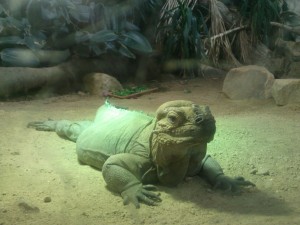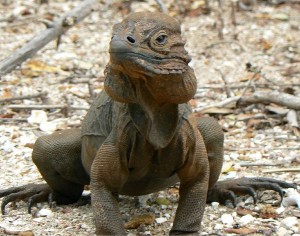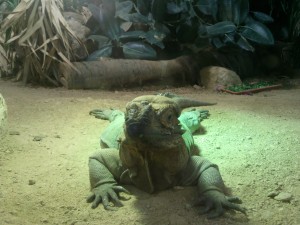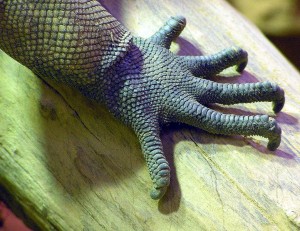Rhinoceros Iguana
 The Rhinoceros Iguana is a threatened species of iguana, mainly found on Hispaniola, a Caribbean Island. These iguanas can also be found throughout parts of Haiti and the Dominican Republic. Rhinoceros Iguanas, Cyclura cornuta, belong to the genus Cyclura. Iguanas are one of the families of lizards. The IUCN have classified this species of iguana as ‘vulnerable’.
The Rhinoceros Iguana is a threatened species of iguana, mainly found on Hispaniola, a Caribbean Island. These iguanas can also be found throughout parts of Haiti and the Dominican Republic. Rhinoceros Iguanas, Cyclura cornuta, belong to the genus Cyclura. Iguanas are one of the families of lizards. The IUCN have classified this species of iguana as ‘vulnerable’.
Rhinoceros iguanas can grow up to 4.5 feet long in length, averaging at about 2 – 4 feet long. On their snout they have a bony outgrowth, which somewhat resembles a rhino’s horn, hence the lizards’ name of ‘rhinoceros iguana’. The majority of adult iguanas of this species way around 4.5 kilograms.
 These lizards can vary in colour quite a lot from a dark brown to a greyish colour going through greens and blues.
These lizards can vary in colour quite a lot from a dark brown to a greyish colour going through greens and blues.
The diet of the rhinoceros iguana is mainly herbivorous, consisting of berries, plant vegetation and flowers, however a few individuals have been observed consuming snakes, insects and small lizards. It would appear that these iguanas are adapted to help many plants germinate faster, through eating their seeds; a study in 2000 by Dr Allison Alberts, showed that those seeds that passed through digestive systems of iguanas, germinated significantly quicker than seeds which weren’t eaten by these lizards.
 Rhinoceros iguanas are the most common species of iguana kept in captivity and in many cases involved in breeding programmes; despite this there are only believed to be 10,000 – 16,000 rhinoceros iguanas left in the wild.
Rhinoceros iguanas are the most common species of iguana kept in captivity and in many cases involved in breeding programmes; despite this there are only believed to be 10,000 – 16,000 rhinoceros iguanas left in the wild.
‘Iguanario of Los Tocones’ is a conservation programme for these lizards, and as of 2009 they plan to reintroduce rhinoceros iguanas to the Samana peninsula.
 Rhinoceros iguanas differ from other members of the same genus, due to being the only species where the males sexually mature at the age of 4-5 years.Females of the same species reach sexual maturity at 2-3 years of age, when they are ready to mate. The mating season begins at the first rainy season of the year, usually around May and June. Mating can then last for 2 or 3 weeks. Usually within 40 days of mating, the females will lay between 2 and 34 eggs, with around 17 being the norm. Rhinoceros iguana eggs are one of the largest lizard eggs in the world. The incubation period lasts around 85 days.
Rhinoceros iguanas differ from other members of the same genus, due to being the only species where the males sexually mature at the age of 4-5 years.Females of the same species reach sexual maturity at 2-3 years of age, when they are ready to mate. The mating season begins at the first rainy season of the year, usually around May and June. Mating can then last for 2 or 3 weeks. Usually within 40 days of mating, the females will lay between 2 and 34 eggs, with around 17 being the norm. Rhinoceros iguana eggs are one of the largest lizard eggs in the world. The incubation period lasts around 85 days.
 December 3, 2010
·
December 3, 2010
·  Maddia (Admin) ·
Maddia (Admin) ·  2 Comments
2 Comments
 Tags: iguanas, lizards, rhino iguanas, rhinoceros iguanas · Posted in: Iguanas
Tags: iguanas, lizards, rhino iguanas, rhinoceros iguanas · Posted in: Iguanas



2 Responses
Enjoy the new design. I enjoyed this article. Thank you for this great entry.
I agree!